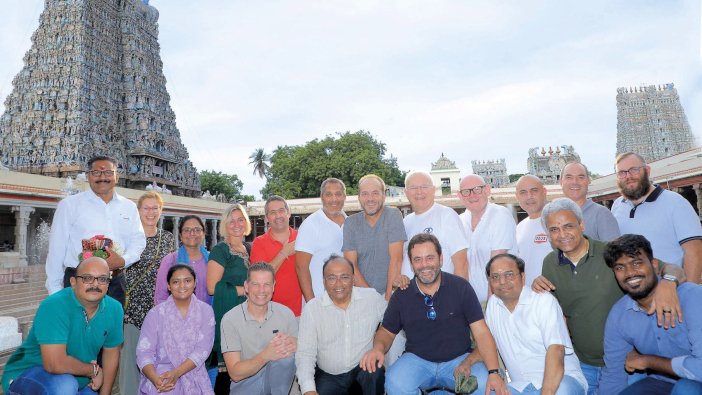Celebrating 65 years since it was established, TAFE Tractors is the third largest tractor manufacturer in the world and looks set to become a truly global producer with its new European range of machines
TAFE (Tractors and Farm Equipment Limited) isn’t an unknown brand in Europe, but while we are all aware of the name, its retail history in Western Europe has been slight. Many of its machines have been designed for the huge Indian market, in which the company has a 20% market share, selling around 200,000 tractors each year, as well as various implements.
“TAFE exports to over 80+ countries through its signature brand, TAFE Tractors, for international markets,” explains Dr. Lakshmi Venu, vice chairman. “Our core value of customer centricity is deeply anchored in the principles that drive it, a strong investment in our people and enduring relationships with our customers, partners, and distributors. As a company rooted in the farming sector, we remain acutely aware of our environmental responsibilities and are committed to exploring meaningful ways to contribute positively to both society and the planet.”
Now the company is aiming for a global position within the sub-100hp market, with new European-style tractors coming to market. To see how these machines have been developed, we were lucky enough to head out to Chennai, India, to look around the company’s facilities and get behind the wheel of the machines.
If we start with the tractors first, we were shown two variants of the 7515, and the company’s Tractor of the Year entrant, the fully electric EV28. The GE version of the 7515, without a cabin, could be a viable option for those working in orchards, vineyards, or other narrow crop scenarios.
The 7515 GE has an in-house, three-cylinder engine producing 74hp, put to the ground through a 12-speed gearbox, with high-medium-low ranges and a mechanical shuttle. The version we tested on the day wasn’t 100% set up for the European market, with a very long bonnet and a front axle setup that meant it had a very wide turning circle.
José María Gil Martínez, European product manager, noted that for tractors to be sold in Europe, the company was looking at a different tyre offering and new spacers on the front axle to provide a tighter turning circle. Just for comfort, if being used for a longer period of time, an adjustable steering column would be a nice touch as well.
It doesn’t have a flat floor, but it remains a comfortable machine to drive. Gear shifts were smooth, and the acceleration was impressive. While the cab version will no doubt have a bigger place in the UK market, this could easily find a spot within hobby farms and on stable yards.
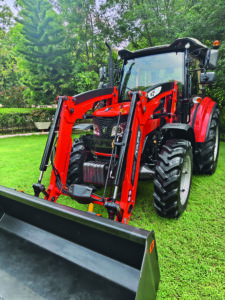 The 7515 with the cab is a completely different proposition. Not just a series of adjustments to make it suitable for the European market, but a genuine cost-effective, low-horsepower option for yard work.
The 7515 with the cab is a completely different proposition. Not just a series of adjustments to make it suitable for the European market, but a genuine cost-effective, low-horsepower option for yard work.
The cab has plenty of visibility, a flat floor and integrates some nice features while retaining the easy-to-use, cost-conscious mentality behind the TAFE brand. If there was a complaint about the machine, it’s that the design of the three-way range splitter, down to the right-hand side of the operator’s seat, is a little tight. It took a little force to get the machine into high range, but the gearing was smooth to shift through, and we could pull away in second gear with no issues.
A very simple solution was the lever for controlling the rear linkage at the headland. Once the upper and lower heights are set for operation, the lever pushes into the right-hand console to lower the link arms and then pulls out to lift at the end of the pass. It’s a neat touch that will provide consistency when heading out into the field.
It’s a lightweight unit, with 74hp up front and a rear lift of 2,600kg, with a 60 litres/min hydraulic system, with a secondary 20 litres/min pump for the steering. As a secondary tractor in a small or medium-sized grassland operation, powering a tedder or a rake, it could be a valuable addition.
Thanks to a tie-up with Quicke, TAFE will offer the 7515 with a front loader, with a 1,200kg capacity. The version we tried had no third function, but José says that all models sold in the UK so far have been fitted with this, with many going onto farms with a muck grab or bale squeeze.
Development is continuing within the cab range as well, with a Cat 4 option in the pipeline to enable the 7515 to be paired with a lightweight sprayer. TAFE is also working on a flagship model, which will increase the power to over 100hp, which is due to come to market soon.
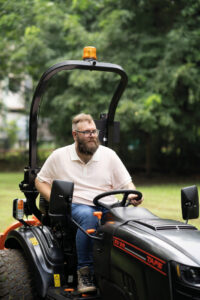 Going electric
Going electric
The company’s Tractor of the Year contender, the fully electric EV28 is a neat little unit, with multiple electric motors, which the company states provides nearly 100% efficiency, and a fully automatic transmission, meaning there’s no clutch pedal and the accelerator is split into forward and reverse.
We won’t go into all the technical details here; those can be found in Tractor of the Year Preview. Instead, we’ll focus on the driving experience. The EV28 feels well balanced, with a 200kg battery unit mounted up front on silent blocks to protect the casing from vibrations. The individual motors will also be beneficial for running rear implements as the PTO and hydraulics can be set individually to the ‘engine’ speed.
It’s a machine that has taken six years to develop and is continuing to be developed. The company noted that as battery technology continues to lower in price, the power output of the machine could theoretically increase, so while the current EV28 is marketed towards the 30-35hp market, although it peaks at around 43hp, an EV model in the future could offer significantly more.
Additional functionality includes hill assist, enabling the transmission to hold the tractor in place, and there are two cruise control memories, which are easy to save and activate. Our only issue was the momentary dip in power when the cruise control is activated, almost as if the machine has to drop back to stationary before building up to speed. If conducting field work, this will have to be kept in mind.
As you’d expect from an electric machine, the power transfer is instantaneous, meaning you get a rapid response from the acceleration. Driving with the pedals, rather than the cruise control, we were impressed with the responsiveness. With a four-hour runtime, it should also be ample when you consider the size of the machine.
It’s currently only available as a platform machine, but José explains that the company is working on a cabin to fit the EV28. “We’re looking for a solution that will not impact the overall autonomy of the machine.” Alongside the possibility of a cabin, the company will offer a front PTO system as a dealer/distributor fitment.
Building TAFE
While TAFE is headquartered in Chennai, we travelled nearly 500km south to Madurai to see one of the company’s tractor plants. While manufacturing initially took place in the centre of Madurai, known as the City of Temples, the company shifted to a custom-built factory outside the city in 1979.
The plant itself is 121,406sq m, with a 24,281sq m farm on site and a total area of 271,139sq m, meaning there is plenty of scope to expand. More than 1,000 people work on the line at the factory across two shifts, with the total production capacity reaching 220 machines per day.
Across the group, the company produces 200,000 tractors each year, as well as 300,000 engines. Over the coming years, it aims to increase this scale to 400,000 machines by 2030.
There is only a single production line at the factory, using the Kaizen lean manufacturing process that ensures the correct parts are delivered to each station at the exact time they are required. Using a single line, the company can produce 23 models for the domestic market (with a total of 61 variants) and 65 models for export, with 473 variants.
The process starts with the rear axle, then the transmission and chassis are built, and the base of the machine then goes through the paint shop. Once the painting is completed, the machine moves onto the line for final assembly.
A barcode system is used throughout the production, enabling full traceability through the line, and each machine goes through a roller check, dynamometer and running check, as well as a UV check for leaks.
An interesting point that arose during a press conference with the company’s chairman and managing director, Mallika Srinivasan, is that TAFE machines are designed to be robust. Despite the average farm size in India being just 1.1ha, tractors are used intensively and often in very difficult conditions. Tractors can be used for more than 2,000hrs each year, so every TAFE machine is developed to deal with this sort of workload.
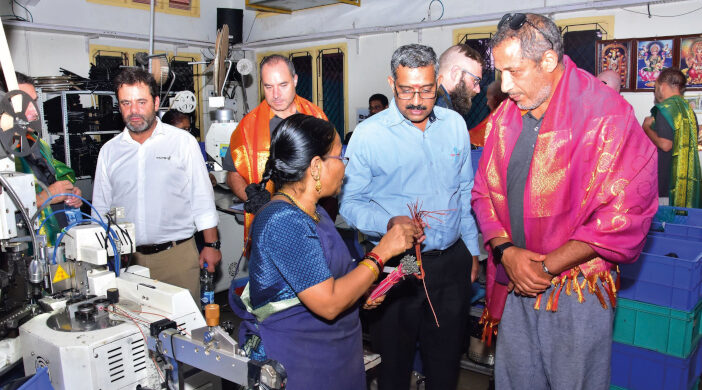
Moving out of the factory and we visited the J-Rehab centre, established by the chairwoman’s father, A Sivasailam. Recognising that there were women in the Madurai area with physical disabilities who were not only unable to work, but who risked being seen as a burden and shunned by their families, Mr Sivasailam set the business up to develop wiring looms in 1980.
The advantage of the work is that the women could remain seated while threading the wires through the harness. At present, the business hires 69 women, with stipends offered until they are fully trained, and meals and transport provided for each employee.
More than 7,000 harnesses are created each day, including the main wiring loom for the tractor, battery cables, fender wiring, as well as tool bag kits for customers. As well as providing a vital source of income for these women, TAFE also holds regular health checks, including the offer of physiotherapy, cancer checks and eye tests.
It was just one example of how the company has not only boosted its own position within the country but also provided opportunities for Indian citizens who may not have the advantages of others.
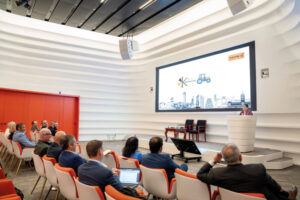 A global leader
A global leader
In the concluding press conference, we were given an indication of TAFE’s aspirations. Sandeep Sinha, CEO, explained: “Europe is for the long term; it’s a mature market with discerning customers. We have spent a lot of time in the field with the European customers, understanding their needs and pain points to deliver farming solutions that meet their expectations in terms of quality, technology and global standards backed with strong after-sales support.”
He then touched on the new partnership between TAFE and Deutz engines, which will see the Indian manufacturer take on Deutz engine production from 2027 – a key part of the company’s desire to scale engine production to 400,000 units. Up to 30,000 Deutz engines will be produced in the TAFE factory at Alwar, Rajasthan, initially in 2.2 litre and 2.9 litre specifications for the sub-100hp market.
Acknowledging the differences between the Indian and South Asian markets and the European market, TAFE has continuously invested in digitisation. However, Sandeep was quick to point out that quality and features were very different things, indicating that the company would focus on longevity and usability, rather than innovation for the sake of innovation.
Its brand-agnostic Terra system is a mobile and desktop platform that can be integrated into TAFE machines or linked to other brands. This can be used to share field mapping and precision farming maps, as well as telematics data back to the farm, which can be used within a farm management system.
A key question was whether the company would look to extend beyond 100hp in the future. While there was not a definite no, it was clear that in the short to medium term, TAFE would focus on the 100hp machines. “Below 100hp remains the largest volume market in the world, and that gives us huge scope for expansion within the European market,” Sandeep noted.
“Our aspiration to lead the sub-100 hp globally will be driven by key markets like Europe as it sets global standards in technology, safety, emissions, and sustainability,” Mallika concluded.
TAFE machines are distributed in the UK and Ireland by Comvex Machinery, based in Sunderland. For more information go to www.tafetractors.uk


